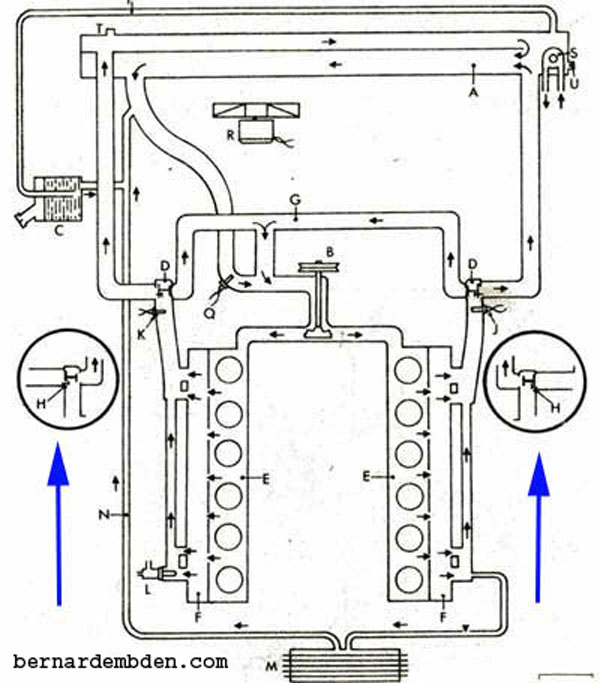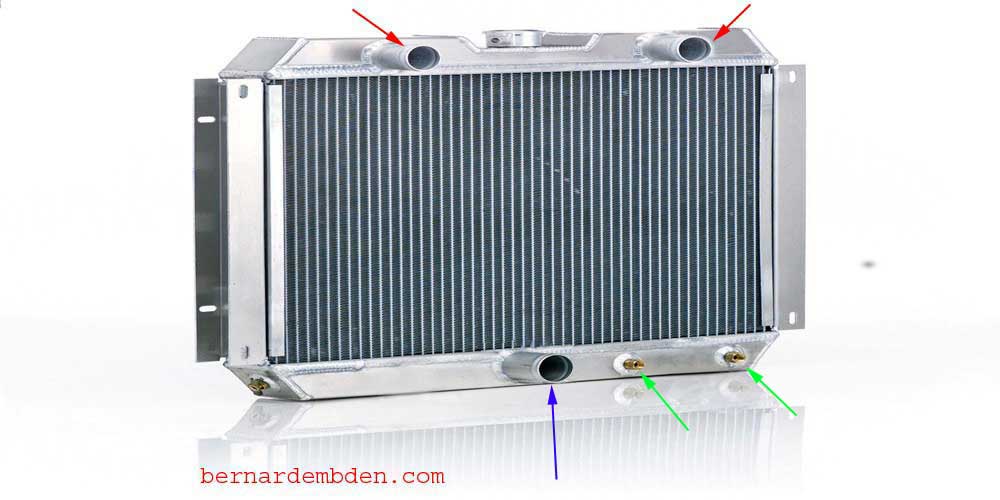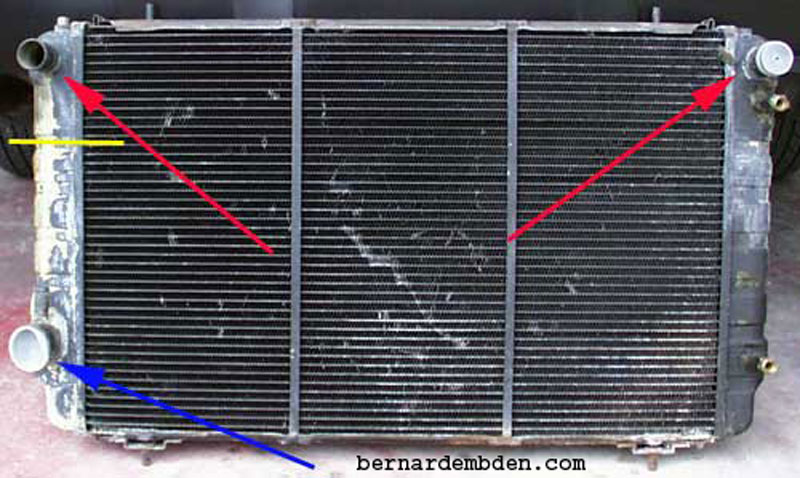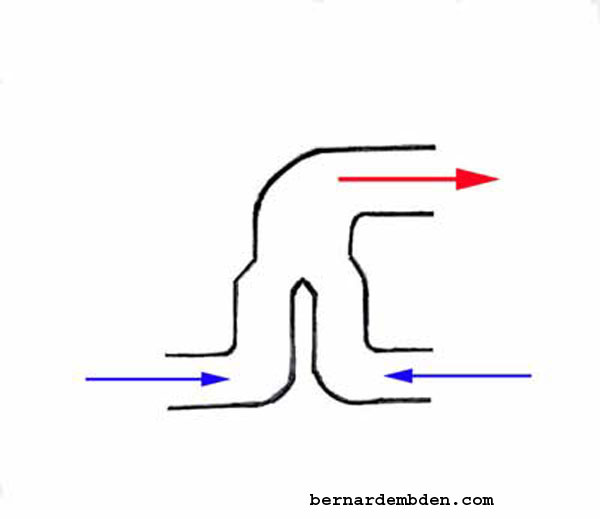

If you own a Jaguar with the V-12 engine you are undoubtedly aware that keeping the engine within its designed operating temperatures is tantamount to keeping the engine alive.
The stock cooling system has been the subject of spirited discussions among V-12 owners/enthusiast for years. It's either a perfectly adequate cooling system or the greatest cooling design fiasco in automotive history.
In a conventional "V-engine" configuration, the cooling system coolant exits the bottom of the radiator and, powered by the water pump, is forced into the engine's water passages in both cylinder banks. An internal engine and or manifold passage then connects the heated coolant streams from both cylinder banks into a single pathway before the coolant, temperature controlled by a single thermostat, returns to the radiator.
Jaguar, in its infinite wisdom, differed from this tried and true design. The coolant is conventionally drawn into the engine via the water pump and around the water jackets. The unusual design feature of this engine is that once the coolant absorbs engine heat, the heated coolant exits the engine via two separate exits, both controlled by individual thermostats. Obviously, at some point in the V-12 engine's design process Jaguar decided to combine the exit coolant from both cylinders banks OUTSIDE the engine, with engine/head coolant temperatures controlled by two separate thermostats.
Combining coolant streams external to the engine with a simplistic external "Y" pipe would not suffice. Probably would not look acceptable in the V-12 engine compartment. Another option would have been a machined part that combined the two coolant streams. A single thermostat at the center exit would then direct the combined coolant streams to a conventional single pass cross flow radiator.
No, Instead The Jaguar engineers, never one to apply a simplistic solution when a far more complicated one was possible, came up with the clever/diabolical idea of combining the two separate cylinder bank coolant streams inside the radiator. This is accomplished by installing a division in the left radiator header to force coolant from the left cylinder bank through the top one third of the radiator. This coolant stream, cooled somewhat by the top 1/3 of the radiator, is then combined with the coolant stream from the right cylinder bank. The combined coolant streams are then cooled conventionally through the remaining 2/3 of the radiator.
Say what you will, love it or hate it, one has to admire the boldness of the idea.
Below is a schematic of the Jaguar V-12 cooling system. The blue arrows identify exploded views of both thermostats. Coolant flow arrows clearly shows coolant from the left cylinder bank flowing through the radiator before being combined with coolant from the right cylinder bank. Note that before the thermostats open coolant is re-routed back to the water pump via the coolant bypass pipe "G" that connects both thermostat housing at the front of the engine.

This is the primary reason why it's disastrous to run this engine without thermostats. Without thermostats a significant part of the coolant volume will go through the bypass tube completely bypassing the radiator.
Critics contend that this system is overly complex, promotes uneven cooling of both banks and if the top 1/3 of the radiator is clogged the engine temperature gauge will not give the driver sufficient warning.
Some have even suggested that the dual pass Jaguar radiator should be immediately scrapped and a conventional single pass, cross flow radiator installed with the two coolant streams combined by a "T" connection before entering the radiator.
In examining this issue, the following represents my opinions only, based on my personal experiences of owning and maintaining cars most of my adult life, and in particular owning and maintaining a Jaguar XJ-S V-12 from 1980 to approx. 2010.
The issue of uneven temperature between engine banks is not unusual. Even with engines that have internal connecting coolant passages there are some incidental differences in engine bank temperatures. The V-12 engine is within those norms.
Roger Bywater (Jaguar Engineer) stated in 2001. "I know for a fact that the V-12 cooling system underwent trials at high ambient temperatures in Nevada without any problems".
Iain Burgess (83 Jaguar XJ-S Brisbane Australia) fitted dual digital temperature sensors to both banks of the V-12 engine and monitored the coolant temperatures under varied driving and climate conditions. During warm up temperatures vary by approximately 4 degrees. At cruising speed (70+ KPH) both engine banks are within 0.1 degree of each other. Temperature variation between engine banks is simply not an issue with the original dual pass radiator.
"Temperature gauge not responding to clogging of the top 1/3 of the radiator ".
On the surface it would seem that if the top 1/3 of the radiator becomes clogged and less efficient that the rest of the radiator, then the combined coolant temperature entering the engine via the water pump would be higher resulting in less efficient cooling. Therefore, any comprise in the cooling capabilities of any portion of the radiator results in the engine operating above its temperature design parameters. This would influence the water temperature gauge regardless of which bank the temperature sensor was located.
In reality this argument is valid due to the unique design of the V-12 Jaguar engine. When the top 1/3 of the radiator does indeed start to clog, the left coolant stream encounters more resistance, thus less flow. The coolant temperature sensor, located in the right engine banks coolant stream will not immediately or effectively indicate the higher temperatures in the left bank.
"The top 1/3 of the dual pass radiator is more likely to become clogged before the bottom 2/3 because the coolant is forced through a smaller section.”
I have cut open and examined several clogged radiators and know people who work on radiators for a living. My experience (and theirs) is that in the real world radiators invariably clogs from the bottom up. The Jaguar V-12 engine is comprised of aluminum and cast iron with a copper radiator. This combination is more susceptible to electrolytic corrosion because different metals suspended in a solution tend to create small electric currents resulting in electrolytic metal transfer to the radiator coolant passages. In addition, old or ineffective antifreeze mixtures leave the small cooling passages in the engine and radiator vulnerable to corrosion. Over time, rust, scale and sediment invariably form inside all radiators. These are usually suspended in the coolant until coolant flow stops when the engine is turned off. These particles then drop out of the coolant and, aided by gravity, attaches itself to the bottom portion of the radiator.
One can argue that the dual pass radiator has two "bottoms". That argument is valid; however I believe the top 1/3 of the radiator, with half the coolant flow moving at a faster rate, is less likely to clog before the bottom which handles the slower coolant volume from the entire engine. Radiators don't clog because of coolant "volume" (more volume routed through a smaller 1/3 section). Radiators clog at shutdown. The bottom 2/3 of the radiator has more coolant volume, therefore more particles suspended in the coolant, therefore more likely to clog.
Below is a picture of the original clogged radiator that I removed, after 19 years, from my 1978 XJ-S. Note that the tubes at the bottom of the radiator (between red arrows) is more clogged than toward the top. (between blue arrows).

Of course, with a properly designed single pass radiator the above arguments do not exist.
Finally, "The cooling system is overly complex".
We own V-12 Jaguars. We love complex systems. Get over It.
The questions that I am always asked are :
1) Is a single pass radiator better that a dual pass radiator? The answer is "Yes".
2) Should I convert my Jaguar V-12 dual pass radiator to a single pass?
"Yes and No".
If you are obsessed about throwing the original dual pass radiator in the garbage and going to a single pass radiator there is only one option that I recommend.
A properly designed down flow custom made radiator.
Down flow radiators have fallen into disfavor as cars designs have become more aerodynamic. There is simply not enough room to accommodate a tall down flow radiator under the low hood designs of the current automobiles. Another disadvantage is that the pressure cap is often placed on the top tank, the hottest part of the radiator with the highest internal pressure. A combination of high RPM and high heat can cause the cap to open prematurely. Finally, with the top and bottom tanks taking space in the frontal air flow, there is less space in that air flow for the cooling tubes.
A cross flow radiator solves all those problems. The header tanks are located to the side, where there is enough room without encroaching on valuable air flow space. With this design, more cooling tubes can be placed in the frontal air flow and the pressure cap can be located on the low pressure tank.
But these problems are not insurmountable. The current dual pass radiator has a small header space where the air purge bleed tube is attached. Making that header another 2 to 3 inches taller would not significantly encroach on air flow space. More importantly, the radiator stops at the bottom of the grill area as it sits on top of the oil cooler.
All that would be needed is a properly designed down flow radiator that would encompass the upper and lower grill areas (if needed) to get the proper amount of cooling tubes.
By extending the cooling tubes into the lower grill area, the total amount of cooling tubes exposed to the frontal air flow would be as much or more that the original dual pass radiator.
The oil cooler can then be redesigned (or replaced) and moved in front of the radiator's lower grill area.Photographed below is a mockup of what the down flow radiator would look like. Red arrows (1 1/2 inch diameter) indicate the entrance from the engines dual coolant streams. Blue arrow (2 inch diameter) indicates the radiator coolant exit after being cooled by the vertical coolant tubes. The green arrows indicate the transmission cooler connections. The external expansion tank and its pressure cap would be retained. A tee connection would either be made in the lower hose connection (as per the original dual pass tank) or easily fabricated to attach the external expansion tank, thus solving the problem of a pressure cap on the top tank header. (in the photograph below the top cap is for filling the radiator only) A similar (to the original) bleed purge tube would be needed to properly bleed air from the top tank.

If done properly a single pass radiator will theoretically cool more effectively and remove the upper 1/3 clogging possibility.
Note however, converting to a single pass radiator, IMHO, if not done properly will result in a cooling system less efficient that a properly functioning original dual pass radiator system.
When conversion to a single pass radiator is considered, the vast majority of Jaguar V-12 owners envision replacing the dual pass radiator with a comparable sized cross flow radiator without the division in the left header tank. The two coolant streams that exit the engine are then forced (via a tee connection) into a necessary single coolant flow in order to enter the radiators right header tank.
Therein lies the problem.
Photographed below is a typical Jaguar V-12 dual pass radiator. The red arrows identify the two top coolant inlets. These are 1-1/2 inch inside diameters in size. The blue arrow identifies the bottom coolant exit. This opening is 2 inches inside diameter in size. Using the area of the circles as comparison, the combined two top radiator openings are 12.5% larger than the single bottom outlet. The yellow line shows where the left header tank is divided to force coolant from the left bank through the top 1/3 of the radiator.

I believe a properly designed radiator should have the same (or larger) size inlet at the top (coolant entrance) as the bottom (coolant exit). Examining the radiator on my V8 Jeep Grand Cherokee confirms that both the top and bottom openings are the same size. (2 inches inside diameter)
In any evaluation of the Jaguar V-12 radiator the total size of both 1-1/2 inch I.D. top inlets must be considered in the radiator's ability to properly handle the coolant volume as it returns from the engine.
A proper conversion to a single pass radiator must then address two issues.
First the size of the single top radiator inlet.
Second the methodology used to combine the two coolant streams outside the radiator.
Any conversion to a single pass radiator that retains the same size 1-1/2 inch top coolant inlet is less efficient that the original. The single 1-1/2 inch top fitting will create a restriction to the two combined coolant streams resulting in increased backpressure as the coolant exits from the thermostats. Cooling efficiency is then diminished.
Any conversion to a single pass radiator that uses a "T" fitting is less efficient that the original. A "T" fitting forces one coolant stream (typically the left engine bank blue arrow drawing below) at right angles to the other coolant stream (red arrow). Both coolant streams are compromised (blue arrow more so than red arrow).

In this case the left cylinder banks are subject to more coolant backpressure than the right bank, resulting in less cooling to the left side of the cylinder bank and increased temperature variations between cylinder banks.
Any conversion to a single pass radiator that uses three 1-1/2 inch inside diameter fitting to combine the coolant flow is less efficient that the original. Two 1-1/2 inch coolant streams that combine into one should not exit in the same 1-1/2 inch size pipe. The original Jaguar design provided two 1-1/2 inch I.D. pipes for the coolant exiting the engine to enter the top of the radiator. I believe the coolant entry at the top should be at least the same size as the coolant exit at the bottom of the radiator. The proper dimensions for the fitting that combines the coolant streams should be 1-1/2 inch I.D. from the thermostats and 2 inches I.D. to the top of the radiator.
In addition, if a deficiency of the dual pass radiator is that it fails to equalize temperatures and pressures between engine banks, then any proper conversion should address those issues. In order to equalize temperatures and pressures each engine bank's coolant stream needs to encounter the same restriction to the radiator. To accomplish this the fitting that combines coolant streams need to be a "Y" configuration. (drawing below).

In this type of fitting both coolant streams (red arrows) sees the same resistances as the streams are combined into one pipe. (big red arrow). Finally the two coolant hoses from the thermostat to the "Y" fitting should be kept as close to equal as possible to minimize pressure differential between cylinder banks.
In conclusion, a proper conversion to a single pass cross flow radiator should have the following.
1) Custom made radiator with 2 inch I.D. inlet and outlet.
2) A customized "Y" connection that equally combines both coolant streams from the thermostats.
3) Connections from the "Y" to the thermostats should be 1-1/2 inch I.D.
4) Connection from the "Y" to the top radiator should be 2 inches I.D.
5) Hose connections from the "Y" to the thermostats should be as close to equal as possible.
If the above concerns are not addressed in any single pass radiator conversion then the cooling system is not improved. On the contrary the likelihood is that the stock cooling system has been compromised and made less efficient.
A proper single pass radiator conversion, using a similar sized cross flow radiator, would most likely require the fabrication of a custom "Y" fitting to be located in front of the radiator similar to the drawing pictured below. The blue arrows represent the coolant streams (1-1/2 inch I.D. pipe) from the engine thermostats. The red arrow represents the 2 inch I.D. pipe to the radiator top inlet.

This would equalize pressures from both thermostats and if located centrally in front of the engine, would allow equal length hoses back to the thermostat housings. A 2-inch inside diameter hose would then be routed from the custom fitting back to the inlet side of the radiator.
In the real world the cramped V-12 engine compartment means that the design has to be compromised to fit. There are always "tradeoffs" between a theoretical design and the practical application of that design. The first tradeoff is locating the custom Y fitting at the center of the engine, equidistant between the thermostat housings. The A/C compressor, coolant bypass pipe, drive belts and limited hood clearance will almost certainly determine a location less than ideal. Space limitations between the engine and radiator will impact ideal coolant hose routings. Two 90-degree bends from the thermostat housings into the custom fitting and an additional two 90-degree bends from the fitting to the radiator seem unavoidable in routing the combined coolant streams from the engine back to the radiator.
In the final analysis the inevitable real world trade offs might compromise the design to the point where any theoretical advantage of a cross flow single pass radiator is lost.
At this point the Jaguar dual pass design doesn't seem quite so terrible after all.
I am not suggesting that any conversion to a single pass radiator be reversed. On the contrary, if the engine operates within it's designed operating temperatures then leave it alone.
What I am suggesting is that a large percentage of single pass radiator conversions not only offer no advantages to the stock system, but these conversions can create new problems that result in a cooling system inferior to the original.
Quoting from "Performance for your Jaguar" a 2002 booklet from AJ6 Engineering, owned by Roger Bywater (Senior development Engineer at Jaguar cars in the 1970s working almost exclusively with the Jaguar V-12 engine) and Ray Timmins. They had this to say about the stock Jaguar cooling systems and the dual pass radiator on the V-12 Jaguars.
"Despite what some might claim there is nothing at all wrong with Jaguar cooling systems as long as they are in good condition. That they are sometimes complicated (particularly the V-12) does not mean they can be neglected"
.
My conclusion is that the stock Jaguar V-12 cooling system, under normal driving conditions is perfectly adequate for the car. If the system overheats find and fix the problem. The overheating is not the result of a design problem. A component of the cooling system is probably defective. Replace or repair the component.
I am always amused at those who swear that they have converted to a single pass cross flow radiator, which has cured all their overheating problems and the car now runs cool in even the hottest weather. The single pass cross flow radiator is not what is preventing the car from overheating. The new (or repaired) radiator is what's preventing the car from overheating.
I have never heard of anyone with an overheating problem who has kept the same radiator, fan, fan clutch etc. Did not have the radiator flushed or repaired. Who then removed the radiator header tank divider and converted to a single pass cross flow system; say that their overheating problem is fixed.
The stock Jaguar V-12 cooling system needs to be properly maintained, not redesigned.
